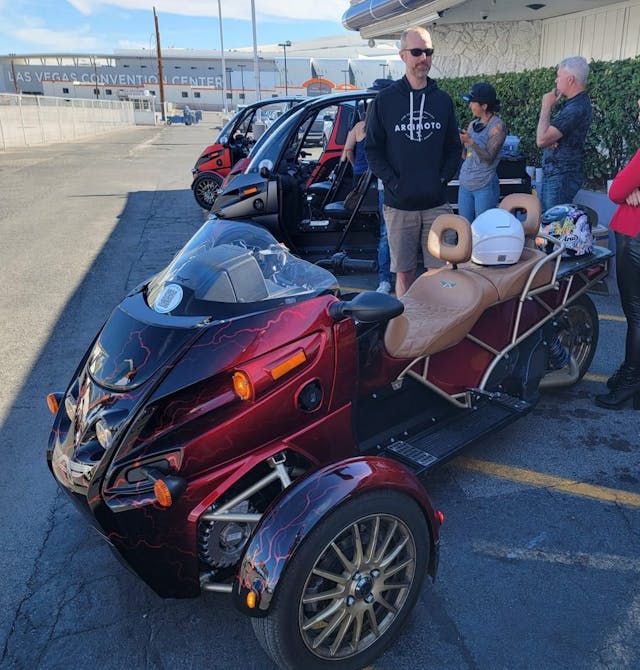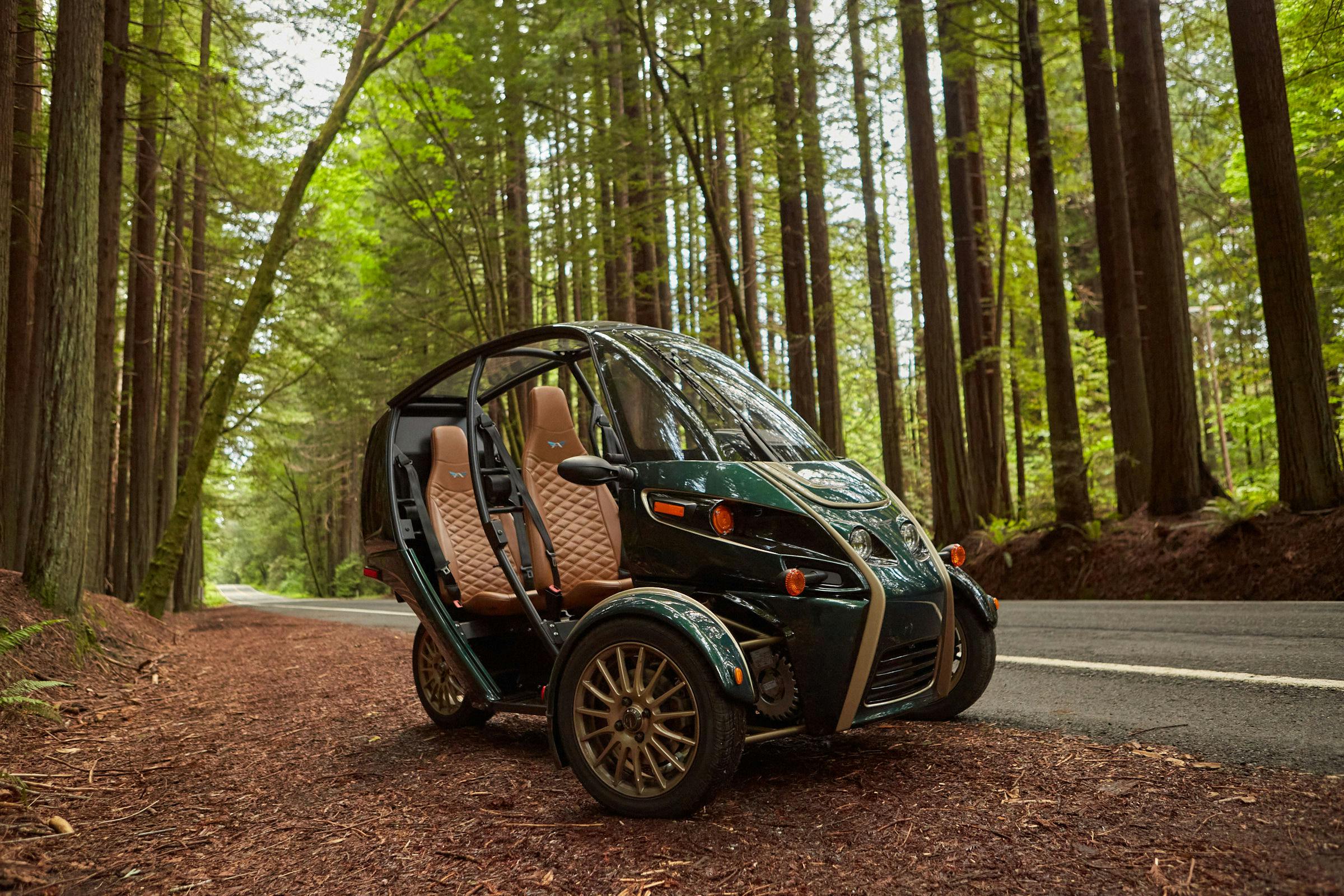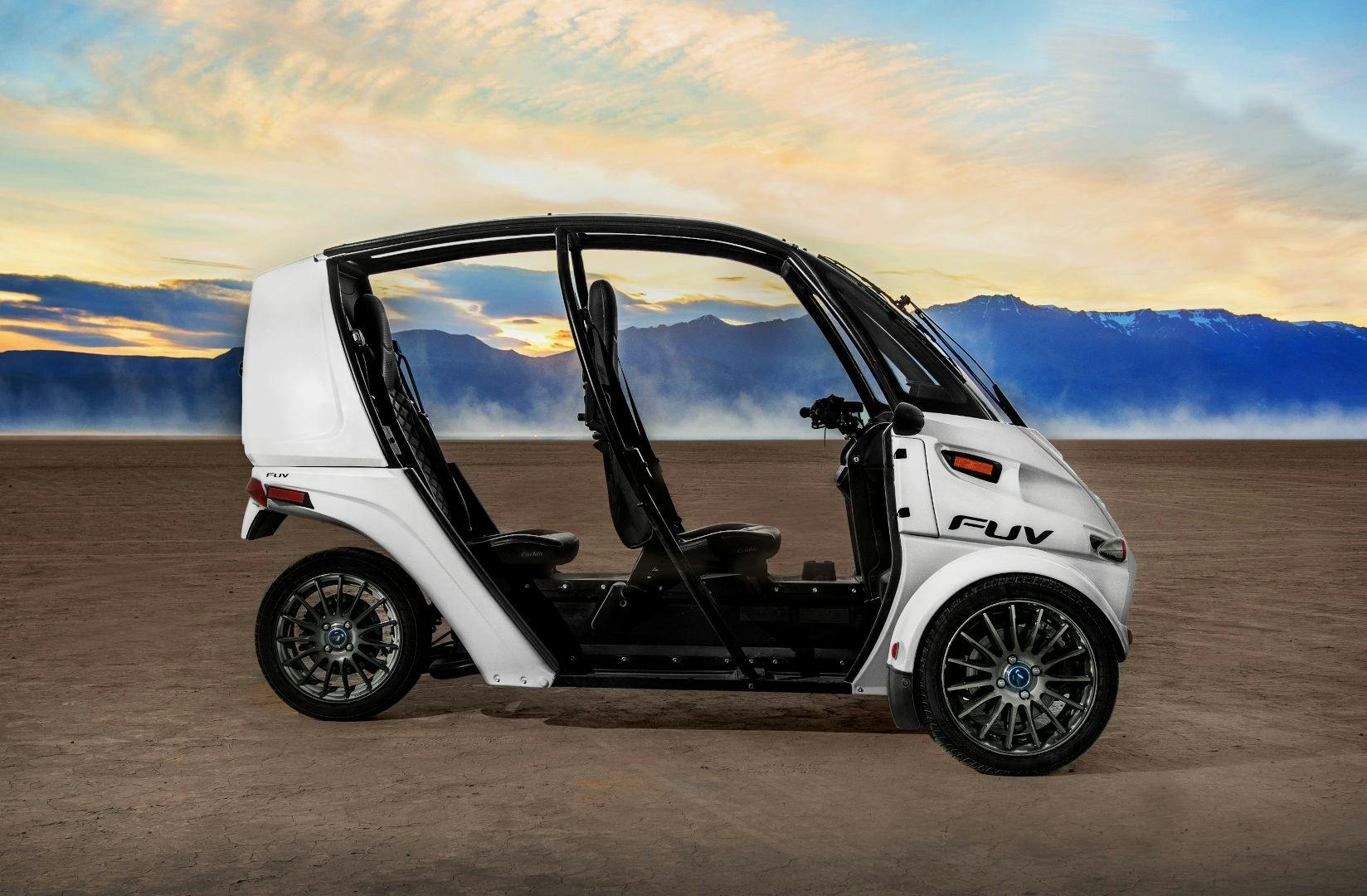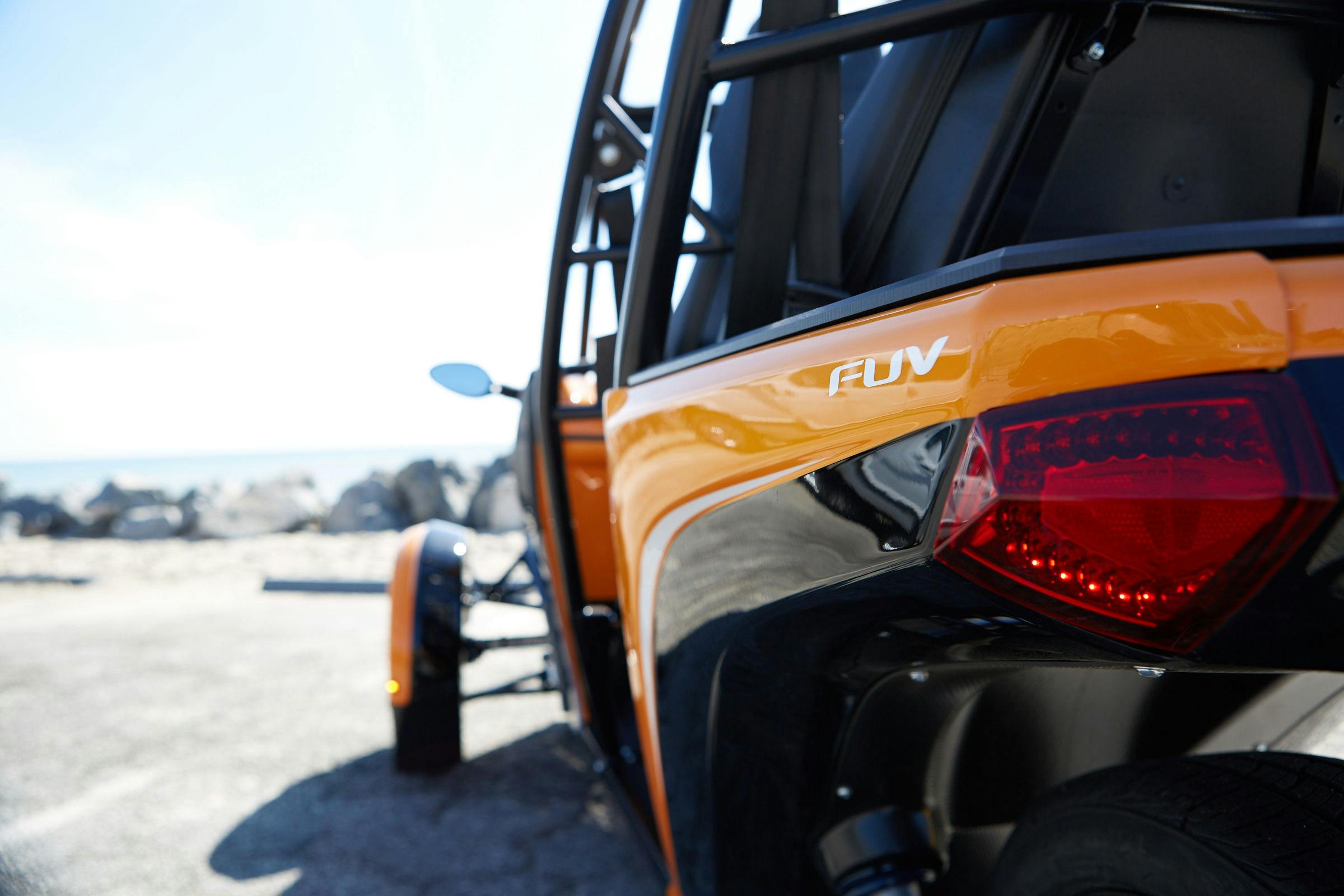Avoidable Contact #123: A world of 75-mph electric trikes, now with sidecar dogs

Eighty-one horsepower, 1300 pounds, two seats. Sounds like some dream specs for a Spridget-based SCCA road racer, right? Add the following: heated seats with quilted leather, Bluetooth stereo, traction control, front-wheel-drive. Now we’re talking some kind of 1976 Honda Civic CVCC Reimagined By Singer, I think. A price of $17,999 removes that possibility … but what about a potential $7500 tax credit from the ever-helpful United States Government, assuming some pending legislation is passed? That clarifies things a bit, because Uncle Sam likes nothing better than taking money from normal motorists (via taxation) and giving that money to the proverbial electric dreams (via transfer payments). This must be a battery-powered something.
As it turns out, Arcimoto’s lineup of electric trikes is several battery-powered somethings. The core vehicle is the “FUV”, or Fun Utility Vehicle, a tandem-style two-seater with a BMW C1-ish roll-structure-plus-roof setup, some lockable storage, and all of the above listed virtues. Remove the rear seat and the FUV becomes a “Deliverator” mini-van (as opposed to a minivan) for “last mile deliveries,” a “Cameo” vehicle with a rear-facing, open-air second seat for film and photography work, or a frisky little one-seat pickup for anything your heart might desire. And now there’s a stripped-down “Roadster” that uses the same basic machinery in a form factor that strongly resembles a Can-Am Spyder—plus, of course, a sidecar-like faired-in platform for your dog.
Knowing that I would be attending the SEMA show in Las Vegas this week, Arcimoto invited me to meet its hyper-enthusiastic CEO, Mark Frohnmayer, and try out both an FUV and a Roadster on the roads surrounding the Las Vegas Strip. With over 400 completed vehicles to its credit across the past five years, Arcimoto is somewhere south of “functioning motorcycle company” but well north of “graft-centric EV vaporware scammers,” so I was more than happy to spend an hour or so with the firm’s products.
Before driving the Arcimotos, however, I wanted to get a sense of the company’s values and priorities from the man in charge. To my immense satisfaction, Arcimoto assembles its vehicles in an Oregon factory from a parts base that is largely American and European in origin. Much of what you see and touch on the FUV is made in America. The two electric motors driving the front wheels are sourced from Italy. The batteries and much of the electronic content comes from the Far East, and will likely continue to do so until some decision-maker in our government decides it’s worth encouraging the product of those components on our shores once again. Don’t hold your breath on that.
The performance envelope of the FUV is adequate for a lot of uses, with a stated 75-mph top speed and range up to 100 miles, depending on how often you want to hit the aforementioned figure, but Frohnmayer is careful to position and emphasize Arcimoto as a company that makes additional vehicles, rather than primary vehicles. There are a lot of towns in America where people use golf carts or side-by-side off-road vehicles for short trips; the FUV could handle most of that and more besides. Yes, you could theoretically take the FUV from Chicago to Joliet and back every day, but you probably wouldn’t want to do it.
What’s the FUV like to drive? In a phrase: not that bad. You sit down facing a set of Gold-Wing-style handlebars and you put on two seatbelts that work like a harness to hold you upright as well as prevent your inadvertent ejection. A twist throttle increases speed, while a small two-finger blade lever on the right bar applies regenerative braking. For more severe stops, there’s a foot-pedal brake on the right floorboard. You face a screen that can be configured to display everything from remaining range to the music you’re hearing. A small panel of touch-sensitive buttons controls the windshield wiper, the traction control, the parking brake, and a few other features. It’s easy to understand, easy to get started …
… and not that difficult to drive, with one major exception. Arcimotos have two front wheels, and therefore you steer the bars in the desired turning direction, rather than “countersteering” into a turn the way you would on a motorcycle. The steering effort is also remarkably high at low speeds. Frohnmayer says that there is a software update coming that will assist steering by providing uneven amounts of power to the two front wheels. “You’ll park with one finger,” he promises. Until then, you’ll need a bit of upper-body strength to make this vehicle work in tight surroundings.
As you’d expect, given the position of the seats, the FUV feels a bit tippy in turns above 20–25 miles per hour, but as long as you treat it with respect there shouldn’t be any issue. It feels significantly more stable than a Can-Am Spyder, which is good. There’s surprisingly little wind intrusion at speed, which was not really a blessing in the Las Vegas heat but which will make the vehicle more usable in some parts of the country. The FUV accelerates steadily and smoothly to the promised 75 mph, with about the vigor you’d expect from a Honda CR-V. Once at top speed it’s stable and reassuring. A Gold Wing would feel less nervous but a Can-Am would feel more so. I didn’t try anything in the way of freeway-speed evasive maneuvers, but I did do a little tire-warming waggle at 40 or so and I didn’t see a wheel lift off the ground in response, which is good.

I then switched over to the Roadster, which trades the traditional upright seating of the FUV for motorcycle-style straddle seats. It still has floorboards, rather than footpegs, which feels odd for a bit. Frohnmayer claimed it would out-handle a Can-Am Spyder, and based on a five-mile test ride I’d say he’s correct. The two big differences between the two trikes: the Arcimoto is front-wheel-drive, and it has batteries running all the way down the bottom of the vehicle frame. This makes for a low center of gravity and a significant increase in cornering speed. It’s hard to imagine a situation in, say, Manhattan where the Roadster would feel underpowered or short on cornering ability. Frohnmayer credits the removal of the roll structure, which saves 150 pounds, along with a lower seating position. A 45-mph left turn across Las Vegas Boulevard proved to be non-frightening as well as nonfatal; your humble author leaned into the turn a bit, but I have no idea if it really helped.
The Roadster is unashamedly aimed at the empty-nester crowd, right down to that previously-discussed perch on the right side of the driver for a small-to-mid-sized dog. Boomers who are used to traversing their retirement communities via golf cart will find this to be much stouter medicine for the task; imagine doing 75 mph in a Club Car! And it fits in a parking space just 7 feet by 10 feet, absolutely compatible with those little additional garages you see in said communities. Arcimoto’s focus on the “last mile” takes on a little extra meaning when you think of the Roadster’s retiree-friendly configuration; for many customers this could be the last vehicle they ever operate on a public road.
Speaking personally, there are a lot of ways I’d rather spend $17,999;—”Kawasaki ZX-10R” comes to mind, as does “base Ford Maverick Hybrid with 20,000 miles.” But the Arcimoto’s appeal is easy to see. It’s a mostly American-made product that answers some specific needs among its potential customer base. Best of all, it doesn’t expect to replace our gasoline-powered cars. It’s more of an augmentation, allowing you to keep miles and strain off your favorite vehicle while accomplishing most of the same tasks. I like the prospect of voluntarily owning an FUV in addition to my existing fleet much more than I like the idea of having mandatory EV ownership forced down the nation’s throat at the point of a gun (or the point of an IRS audit, which is the same basic idea).
There’s just one little problem with the Arcimoto, and maybe it’s bigger than any of us want to admit: it looks goofy no matter how it’s configured. I can’t imagine it filling in for the Chevrolets in American Graffiti or Two-Lane Blacktop. Maybe that’s deliberate. Sometimes it’s best to look nonthreatening, and a little goofy besides. Ask the ladybug, which survives interactions with humans much more often than its uglier insect relatives can.
Arcimoto’s CEO embraces the humor of the situation; he was passing out T-shirts with a cartoon sci-fi theme to any civilian off the street who drove, and enjoyed, the FUV or Roadster. It’s appropriate. There’s something just a bit Jetsons about the FUV. At the very least, it presages a future more difficult to imagine than almost anything out of a Hanna-Barbera cartoon, namely, a day when the electric vehicle becomes something more than a toy, while still managing to feel quite toy-like. There was once a time when people didn’t take the Honda Civic seriously, you know …







